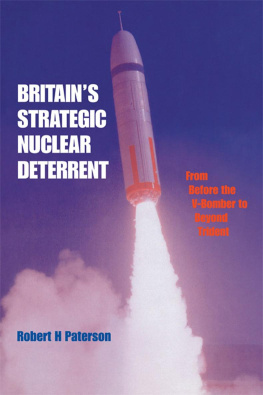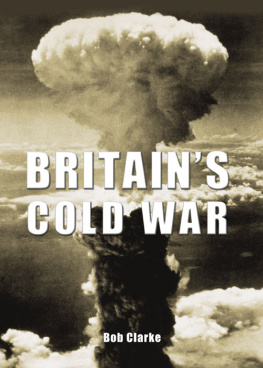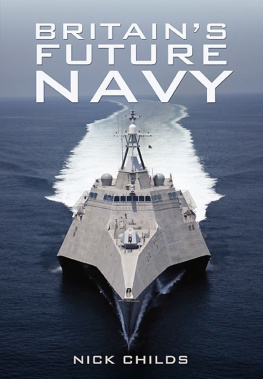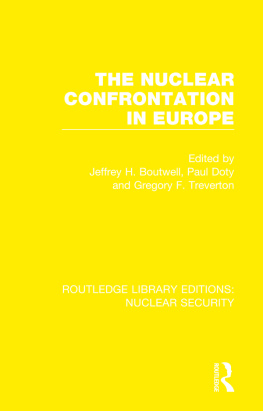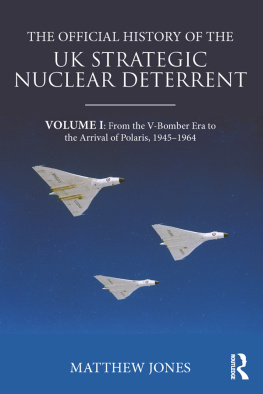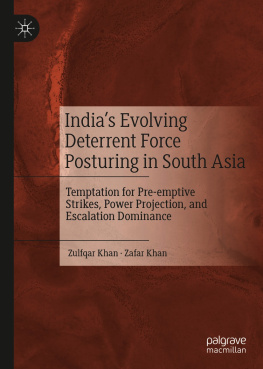BRITAINS STRATEGIC NUCLEAR DETERRENT
BRITAINS
STRATEGIC NUCLEAR
DETERRENT
From before the V-Bomber
to beyond Trident
ROBERT H. PATERSON
First Published in 1997 in Great Britain by
Routledge
2 Park Square, Milton Park, Abingdon, Oxon, OX14 4RN
270 Madison Ave, New York NY 10016
Transferred to Digital Printing 2010
Copyright 1997 Robert H. Paterson
British Library Cataloguing in Publication Data
Paterson, Robert H.
Britains strategic nuclear deterrent: from before the V-Bomber to beyond Trident
I. Nuclear Weapons Great Britain History 2. Deterrence (Strategy) 3. Great Britain Strategic aspects 4. Great Britain Military policy
I. Title
355.8251190941
ISBN 0 7146 4740 3 (cloth)
ISBN 0 7146 4297 5 (paper)
Library of Congress Cataloging-in-Publication Data
Paterson, Robert H.
Britains strategic nuclear deterrent: from before the V-bomber to beyond Trident
p. cm.
Includes bibliographical references (p. ) and index.
ISBN 0714647403 (cloth). ISBN 0714642975 (pbk.)
1. Nuclear weaponsGovernment policyGreat Britain. 2. Deterrence (Strategy) 3. Fleet ballistic missile weapons systemsGreat Britain. I. Title
UA647.P29 1997
355.02170941dc21
9637620
CIP
All rights reserved. No part of this publication may be reproduced in any form or by any means, electronic, mechanical, photocopying, recording or otherwise, without the prior permission of Routledge and Company Limited.
Typeset by Regent Typesetting, London
Publishers Note
The publisher has gone to great lengths to ensure the quality of this reprint but points out that some imperfections in the original may be apparent.
For Andrew and Sandy
Abbreviations
ABM
Anti Ballistic Missile
ALCM
Air Launched Cruise Missile
ASBM
Air to Surface Ballistic Missile
ASMP
Air-sol moyenne porte
ASW
Anti Submarine Warfare
BAOR
British Army of the Rhine
CENTO
Central Treaty Organisation
CEP
Circular Error of Probability
C3I
Command Control Communications and Intelligence
CIS
Commonwealth of Independent States
CND
Campaign for Nuclear Disarmament
CSCE
Conference on Security and Co-operation in Europe
CTBT
Comprehensive Test Ban Treaty
DAC
Direct Action Committee Against Nuclear War
EC
European Community
ECM
Electronic Counter Measures
EMF
European Monetary Fund
EMT
Equivalent Megatonage
EU
European Union
GDP
Gross Domestic Product
GLCM
Ground Launched Cruise Missile
GPALS
Global Protection Against Limited Strikes
IAEA
Independent Atomic Energy Agency
ICBM
Inter-Continental Ballistic Missile
IFOR
UN Peace Implementation Force in Bosnia
INF
Intermediate Nuclear Forces
IRBM
Intermediate Range Ballistic Missile
JSTPS
Joint Strategic Target Planning Staff
kt
Kiloton
MAD
Mutual Assured Destruction
MARV
Manoeuvrable Re-entry Vehicle
MAUD
Military Application of Uranium Detonation
MIRV
Multiple Independently-Targetable Re-Entry Vehicle
MLF
Multilateral Force
MRV
Multiple Re-Entry Vehicle
mt
Megaton
NACC
North Atlantic Co-operation Council
NATO
North Atlantic Treaty Organisation
NCANWT
National Council for the Abolition of Nuclear Weapons-Tests
NPT
Nuclear Non-Proliferation Treaty
NSC
National Security Council
PFP
Partnership for Peace
R&D
Research and Development
SAC
Strategic Air Command
SACEUR
Supreme Allied Commander Europe
SALT
Strategic Arms Limitation Talks
SAM
Surface to Air Missile
SEATO
South East Asia Treaty Organisation
SIOP
Single Integrated Operational Plan
SLBM
Submarine Launched Ballistic Missile
SLCM
Submarine Launched Cruise Missle
SRAM
Short Range Attack Missile
SSBN
Nuclear Powered Ballistic Missile Submarine
SSCN
Nuclear Powered Cruise Missile Submarine
SSN
Nuclear Powered Submarine
TERCOM
Terrain Contour Matching
TSR
Tactical Strike and Reconnaissance (Aircraft)
USAF
United States Air Force
USN
United States Navy
WEU
Western European Union
Acknowledgements
T HE AUTHOR IS grateful to the Controller of HMSO for permission to reproduce Crown copyright material and to Oxford University Press for permission to reproduce material from Navias M.S. Nuclear Weapons and British Strategic Planning 195558, Clarendon Press, Oxford, 1991.
Preface
T HIS BOOK IS about Britains strategic security policy in the second half of the twentieth century. I have had a professional interest in this subject for much of my life and I was able to complement that experience during a period of postgraduate research in the early 1990s. I hope that I have been able to combine these two perspectives to maximum effect while writing this book.
A primary duty of all states is to ensure their continuing survival as independent entities. When the states security is threatened it requires its citizens to contribute directly to its survival. Twice during the first half of this century British citizens responded magnificently to the call to protect Britains vital national interests, albeit with very considerable loss of life. Sadly our record regarding the development of rational strategic security policies has been rather different. The armed forces make a unique, but by no means exclusive, contribution to the nations security policy. Indeed the move from reactive defence to proactive deterrence requires policies to be perceived as credible, both at home and abroad. This, in turn, requires the contribution of informed politicians, officials, academic analysts and, increasingly, a spectrum of citizens. Without the contribution of the latter the legitimacy, and therefore the credibility, of national security policies will remain open to question. This book seeks to help a wider public acquire a greater understanding of Britains strategic security requirements. More specifically it should be of interest to those who wish to understand why Britain chose to procure and deploy a succession of strategic nuclear deterrents and what the implications of that policy have been.
The period that this text covers corresponds to my life span. I was born a few months after the theory of nuclear fission was first published. The bombing of Hiroshima and Nagasaki took place a month before I started school. By the time I had left school the V-bombers were operational, Britain had conducted her first H-bomb test and had adopted the doctrine of massive retaliation. In the summer of 1961, when the Berlin Wall was erected, I was a platoon commander in an infantry battalion in West Germany. When American and Soviet tanks faced each other at Checkpoint Charlie we were placed on operational stand-by to drive up the Helmstedt corridor to Berlin. Happily the international tension dissipated and we were not deployed but I can still remember the adrenaline pumping and my imagination running riot! During the early 1960s I led a number of operational patrols along the Inner German Border. Throughout that period the minefields and other obstacles just to the east of the border were continually being improved to stem the flow of men and women to the West. The opportunity to witness these events on a day-to-day basis, literally on the border between East and West, made a profound impact on my understanding of the division of Europe. By the mid-1960s I was in Cyprus where the V-bombers, based at RAF Akrotiri and capable of reaching targets in the Crimea, were being phased out, leaving Britain without a viable strategic nuclear deterrent. During the early 1970s, by which time the Polaris fleet was operational, I contributed to the planning, conduct and evaluation of the WINTEX series of exercises NATOs biennial command post exercises that rehearsed procedures for the transition to war and operational procedures up to, and including, selective nuclear release. By the late 1980s I was working in a British Embassy in Western Europe. At the start of my tour of duty Britain was maintaining pressure on her allies to deploy land-based cruise missiles in response to the earlier deployment of Soviet SS-20 missiles in Eastern Europe. By the time I left both the intelligence community and informed open sources were reporting massive and startling changes within the Warsaw Pacts force structure. The Berlin Wall was breached in 1989 and a year later Germany was reunified. Half my military service had been spent in Western Europe and the division of Germany had been the focus of my professional life for three decades. The Moscow coup took place in August 1991 and three years later the first Trident boat sailed from the Clyde on an operational patrol. These were momentous events that heralded major changes in Britains security requirements.

